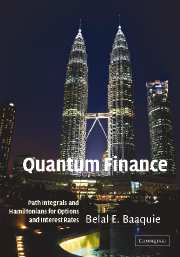Book contents
- Frontmatter
- Contents
- Foreword
- Preface
- Acknowledgments
- 1 Synopsis
- Part I Fundamental concepts of finance
- Part II Systems with finite number of degrees of freedom
- Part III Quantum field theory of interest rates models
- 7 Quantum field theory of forward interest rates
- 8 Empirical forward interest rates and field theory models
- 9 Field theory of Treasury Bonds' derivatives and hedging
- 10 Field theory Hamiltonian of forward interest rates
- 11 Conclusions
- A Mathematical background
- Brief glossary of financial terms
- Brief glossary of physics terms
- List of main symbols
- References
- Index
8 - Empirical forward interest rates and field theory models
Published online by Cambridge University Press: 22 February 2010
- Frontmatter
- Contents
- Foreword
- Preface
- Acknowledgments
- 1 Synopsis
- Part I Fundamental concepts of finance
- Part II Systems with finite number of degrees of freedom
- Part III Quantum field theory of interest rates models
- 7 Quantum field theory of forward interest rates
- 8 Empirical forward interest rates and field theory models
- 9 Field theory of Treasury Bonds' derivatives and hedging
- 10 Field theory Hamiltonian of forward interest rates
- 11 Conclusions
- A Mathematical background
- Brief glossary of financial terms
- Brief glossary of physics terms
- List of main symbols
- References
- Index
Summary
The validity of any model of the forward rates is ultimately an empirical question, and whether the model is useful depends on it being computationally tractable. The computational and empirical aspects are closely related, since only computationally tractable models can produce testable results.
In this chapter, an empirical study of the forward interest rates is undertaken, and due to its computational simplicity only the Gaussian field theory models that have been discussed in Chapter 7 will be analyzed. Nonlinear theories of the forward rates will not be discussed and are left for future studies.
The empirical study of the field theory model of the forward rates is based on data from Eurodollar futures. A brief review of the empirical properties of the forward rates based on the findings in will be presented. The rest of this chapter is focussed on the correlation structure of the instantaneous changes in forward interest rates as a function of maturity.
The theoretical framework for the empirical study is the formulation of the forward rates as a two-dimensional Gaussian quantum field theory. Recall the key feature of the field theory models is that the forward rates f(t, x) are strongly correlated in the maturity direction x > t. To fully calibrate the field theory models, all parameters in the Lagrangians need to be fixed, which consists of numerical quantities like the parameters μ and λ that control the fluctuations in the maturity direction, and the (complete) volatility function σ(t, x) that is a measure of the degree to which the forward rates are stochastic.
Information
- Type
- Chapter
- Information
- Quantum FinancePath Integrals and Hamiltonians for Options and Interest Rates, pp. 191 - 216Publisher: Cambridge University PressPrint publication year: 2004
Accessibility standard: Unknown
Why this information is here
This section outlines the accessibility features of this content - including support for screen readers, full keyboard navigation and high-contrast display options. This may not be relevant for you.Accessibility Information
- 1
- Cited by
